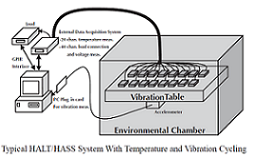
Test Equipment Considerations
HALT and HASS testing are conducted in environmental chambers where high or low temperature, vibration, and other stress conditions are applied to the DUTs. In many cases, additional stresses not associated with the chamber may also be applied. These might include full power (burn-in) conditions and over-voltage conditions. To facilitate multiple DUTs, signal I/O and the application of power, test fixtures usually are employed inside the chamber.
Figure 2 is a block diagram of a typical HALT/HASS test system.
Major considerations in the specification of this equipment include:
• Channel count (associated with lot size and number of signals to be measured)
• Electrical noise (which may be associated with the DUTs, externally coupled into
cabling, or a fundamental limitation of measuring instruments)
• Signal levels (both applied and measured)
• Speed, bandwidth, and throughput of instruments and other pieces of equipment
• Chamber size (associated with lot size, DUT size, and fixturing)
• Fixturing (mechanical design, racks, and special signal considerations)
• Cabling and connectors (selected for applied signal levels, low noise
characteristics, and quick connect/disconnect)
Download full block diagram below
Advertisement

Learn more about Keithley Instruments





